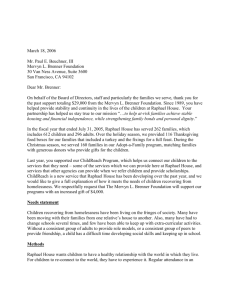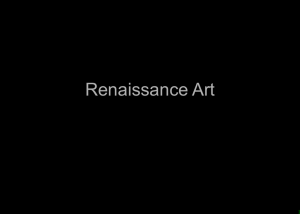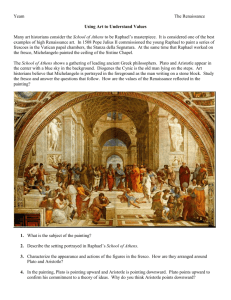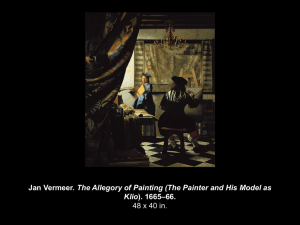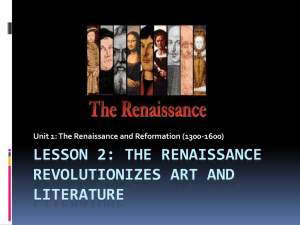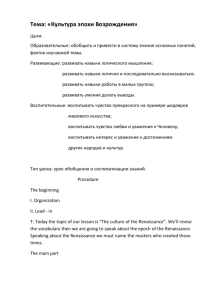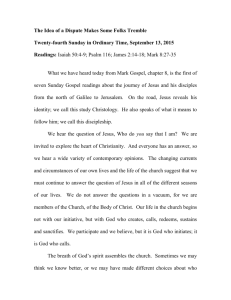Raphael Notes - Franklin Board of Education
advertisement
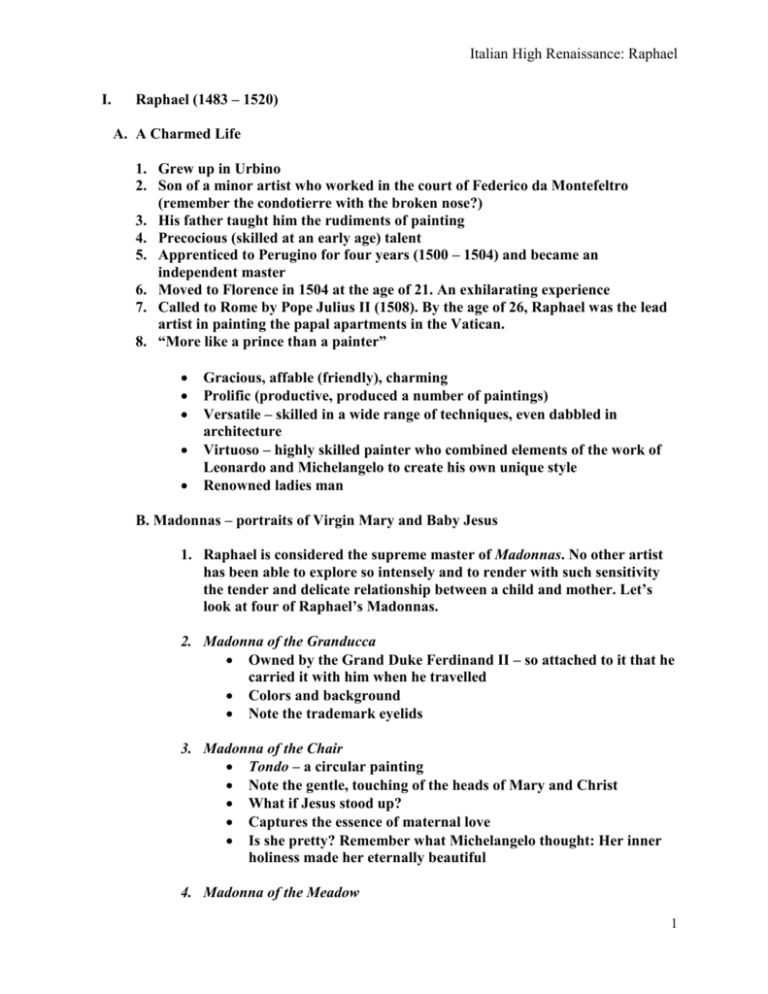
Italian High Renaissance: Raphael I. Raphael (1483 – 1520) A. A Charmed Life 1. Grew up in Urbino 2. Son of a minor artist who worked in the court of Federico da Montefeltro (remember the condotierre with the broken nose?) 3. His father taught him the rudiments of painting 4. Precocious (skilled at an early age) talent 5. Apprenticed to Perugino for four years (1500 – 1504) and became an independent master 6. Moved to Florence in 1504 at the age of 21. An exhilarating experience 7. Called to Rome by Pope Julius II (1508). By the age of 26, Raphael was the lead artist in painting the papal apartments in the Vatican. 8. “More like a prince than a painter” Gracious, affable (friendly), charming Prolific (productive, produced a number of paintings) Versatile – skilled in a wide range of techniques, even dabbled in architecture Virtuoso – highly skilled painter who combined elements of the work of Leonardo and Michelangelo to create his own unique style Renowned ladies man B. Madonnas – portraits of Virgin Mary and Baby Jesus 1. Raphael is considered the supreme master of Madonnas. No other artist has been able to explore so intensely and to render with such sensitivity the tender and delicate relationship between a child and mother. Let’s look at four of Raphael’s Madonnas. 2. Madonna of the Granducca Owned by the Grand Duke Ferdinand II – so attached to it that he carried it with him when he travelled Colors and background Note the trademark eyelids 3. Madonna of the Chair Tondo – a circular painting Note the gentle, touching of the heads of Mary and Christ What if Jesus stood up? Captures the essence of maternal love Is she pretty? Remember what Michelangelo thought: Her inner holiness made her eternally beautiful 4. Madonna of the Meadow 1 Italian High Renaissance: Raphael Raphael includes a landscape Note the graceful positioning of Mary, Christ, and John the Baptist (doesn’t it have similarities to Leonardo) A balanced composition 5. An Amazing Madonna – Sistine Madonna Mary “What beauty, innocence, and sadness in that heavenly countenance, what humility and suffering in those eyes. Among the ancient Greeks the powers of the divine were expressed in the marvelous Venus de Milo; the Italians, however, brought forth the true Mother of God – the Sistine Madonna.” Dostoyevsky Who is Mary? La Donna Velata or The Woman with a Sleeve La Fornarina The love of Raphael’s life Note the band on her arm – “Raphael Urbinas” Two famous angels Ghostly angels in the background St. Sixtus, who was martyred in 258 CE Note the papal tiara Also note the acorns St. Barbara – patron saint of victories 6. Which Raphael Madonna is your favorite? C. School of Athens 1. One of 4 paintings to decorate the Stanza della Segnatura (the papal library) in the Vatican. Commissioned by Julius II. The four themes are: philosophy, theology, poetry, and law. 2. The themes suggest that Pope Julius II is a cultured and educated man both in humanism and in Christian doctrine. 3. Who’s who? Plato (but really ______________________!) with hand and finger pointed upward. Plato represents abstract and theoretical philosophy. He holds his a copy of the Timaeus, his book, in his hand. 2 Italian High Renaissance: Raphael Aristotle – with hand extended outward toward his immediate surroundings. He represents natural and EMPIRICAL (based on facts) philosophy. He holds his Nichomachean Ethics in his hand. Diogenes (412 – 323 BCE) a CYNIC who distrusted human nature, hated worldly possessions and lived in a barrel. This earned him his nickname meaning “the dog.” Heraclitus (535 – 475 BCE) – a melancholy philosopher who regularly wept tears for human folly. But wait! The figure is wearing the clothes of a stone mason! And I think we have seen this pose before. But where? Euclid – Third century BCE Greek mathematician is EXPOUNDING (explaining in detail) one of his geometric principles. Euclid is a portrait of the famed architect Bramante. Raphael and Perugino – On the right hand side, Raphael with his teacher Perugino (Remember his Delivery of the Keys of the Kingdom to Saint Peter) Ptolemy and Zoroaster – Ptolemy was a 2nd century astronomer who thought Earth was the center of the universe. Zoroaster was a Persian prophet Pythagoras – On the left, the renowned Greek mathematician no doubt EXPOUNDING (explaining) on the ____________________________________. Epicurus – A Greek philosopher depicted with a crown of grape leaves. Epicurus taught that happiness lay in the pursuit of pleasure. In short, he was a HEDONIST. Alexander the Great listens to Socrates – Socrates emphasizes individual points with his fingers. Questioning and analysis are at the heart of Socratic philosophy. Apollo and Athena – painted in GRISAILLE to simulate sculpture, the patron god of the arts and wisdom, approve of the gathering of these great minds 4. Perspective and Architecture Where is the vanishing point? What vault extends in the distance? 3 Italian High Renaissance: Raphael This reminds me (at least a little) of Masaccio’s Holy Trinity (remember the “hole in the wall”) Architecture resembles Roman architecture and probably was influenced by the construction of New Saint Peter’s, which was based on Bramante’s design. 5. Great Renaissance Themes Balance and Harmony – Plato (abstract world of ideas) balanced by Aristotle (concrete world of empirical facts) Symmetrical and balanced composition Illusion of a three-dimensional space on a two-dimensional surface, unifies linear perspective, chiaroscuro, and classical interest in the human form Balancing of paganism (Apollo and Athena, and Greek philosophers) with Christianity (School of Athens which is about philosophy is across from the wall with theology) Renaissance individualism – elevating the status of artists (portraits of Leonardo, Michelangelo, Raphael, Bramante, and Perugino) D. Miscellaneous Masterpieces 1. Raphael was a skilled and versatile master. Let’s look at several of his most famous paintings. 2. Portrait of Julius II Note the acorns on the papal throne Also, note the rings on Julius’ fingers Notice the keys on the wall (symbolic of papal power) First known independent portrait of a pope 3. Portrait of Baldassare Castiglione Renowned author of the Book of the Courtier, a guide on how to be a Renaissance man 4 Italian High Renaissance: Raphael Frequently away from home. He wanted the painting so that his wife and son would remember him while he was away Waist up, three-quarters pose – influence of Mona Lisa Raphael blends attention to his physical qualities with psychological insight. What does this portrait say about his personality? 4. Galatea Commissioned by Agostino Chigi, an immensely wealthy banker who managed the papal state’s financial affairs The story – a pagan theme Polyphemus, a fierce, one-eyed giant falls madly in love with Galatea Galatea tries to flee but will she escape? Galatea’s companions are all sons and daughters of sea gods. The females are called nereids and the males are called tritons The composition – Use of circles, use of color, all lines point to Galatea Raphael asked for extra payment. When Chigi’s accountants protested, Raphael brought in Michelangelo to inspect his work. Michelangelo told the accountants that he would have charged much more than Raphael was asking – 100 scudi a head! 5. Transfiguration Transfiguration – Remember the Byzantine mosaic from Saint Catherine’s monastery at Mount Sinai Jesus, James, Peter, and John climb Mt. Tabor There Jesus is transformed. His clothes glowed the whitest of whites and his face became radiant. Jesus was joined by Moses and Elijah. A voice came out of a bright cloud that surround them and said: “This is my beloved Son, in whom I am well pleased; listen to him.” Stunned the three apostles fell face down. Curing a boy filled with evil spirits Meanwhile, the apostles below cannot cure a boy who is filled with evil spirits Jesus returns saying that “All things are possible to him that believeth.” With that, he sent the devil out of the child. This is recognized as Raphael’s last painting before his death. He did not get to finish it and one of his students finished it (painting the lower half of the painting). A. A Sad Farewell to Raphael 5 Italian High Renaissance: Raphael 1. Raphael and Maria Raphael was engaged to a young woman named Maria Maria was the niece of Bernardo Dovizi da Bibbiena, a powerful cardinal who was the subject of one of Raphael’s portraits. But vows were never exchanged. Why? Because Raphael kept postponing the wedding! The constant postponement of her wedding caused Maria to die of a broken heart. 2. Raphael and La Fornarina Many believe that Raphael’s true love was Margherita, the baker’s daughter (La Fornarina). Recent X-ray analysis of Raphael’s 1518 portrait of her has revealed a square-cut ruby ring on the fourth finger of her left hand, suggesting that the real reason why Raphael kept postponing his wedding to Maria was because he was already married to La Fornarina! The ring remained unseen for almost 500 years, having been painted over by one of Raphael’s assistants, in order to avoid a scandal after his death. 3. A Sad Death Struck down by sickness in 1520. Like Shakespeare, Raphael died on his birthday. He was just 37 years old. The papal court plunged into “the utmost and most universal grief.” Raphael is buried in the Pantheon. 4. What ever happened to … His frustrated bride Maria – She and Raphael are buried side-byside in the Pantheon. His true love La Fornarina – Raphael left her a generous inheritance. She entered a convent keeping the secrets of their relationship with her to the end. 6
